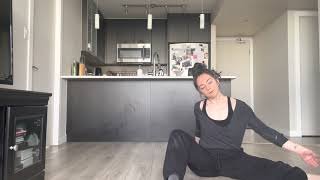FFTT Final Project – Part 1B Written Overview of the Loop
The purpose of this document is to provide a written overview of my loop.
1) What are the easy-to-remember ingredients of your loops? (This could be movements/actions/images)
The easy to remember ingredients of my loop are the following: lying supine with knees bent & feet planted (e.g., a hip bridge without lifting the lips); table top; seated half straddle with stand foot.
2) Describe your process. How did you choose the parts? How was your experience leading up to filming this? What did you need to do to get in the right state of body/mind/spirit to Flow?
I chose the parts as I felt they were accessible and simple positions. I also chose them because of the variety across them: one is lying supine, one is prone and supported on all fours (hands and knees), and the other is seated. Further, I chose the seated half straddle because I like the opportunity it provides to alternate sides/directions given it’s asymmetry.
I chose to film my loop in the morning, since I start all of my days off with a little bit of movement. That habit helps me to start my day on as positive a note as possible. And if I am feeling anxious, stressed, upset, or something else negative, bringing myself down to the floor for even a few minutes can help manage or mitigate or process those feelings.
There are two factors that contributed to me getting into the right state of body/mind to Flow for this loop. First, my morning movement habit is something that I sometimes film for myself and thus I felt comfortable with the task of filming my loop for this project. I think that having these habits in place allowed me to feel ease to drop in to the task for this loop. I did a couple of test recordings (20 or 30 seconds) to ensure that my camera was set up to capture my floor movement as best as possible. I did not want to worry about having a very feel-good loop experience and then come to find out the camera angle did not capture it! Those test recordings provided me ease and so I felt ready to begin filming ‘for real’. Second, I let myself lie on the floor and just breathe before I began. I noticed where I felt tension in my body and sent my breath to those regions, with the aim to soften a little into the support of the floor. When I looked back at the recording this breathing time lasted about 90 seconds (I trimmed some of it to keep my video within the time limit of 5 minutes).
3) What felt good (or provided a healthy challenge) in this loop video experience?
The part of the loop that felt good was using the most fundamental ‘versions’ of each ingredient in the loop as the base line. This eased the pressure to perform or aim for big skills on the floor. Slowing down was a lovely challenge as well. Part of me wanted to really make big sweeping motions with my legs and build the momentum. Before I started, I had thought about so many different ways to remove contact points, speed up, and travel more. I found that starting with a long breathing period and then the intention to move the base loop very slowly put me into a softened, relaxed state where I lost my sense of time passing.
4) If there is ONE thing that you would do differently, what is it?
The thing I would do differently is let go of expectations. I felt that I had a few ‘plans’ in my mind for how I could progress the loop, make it more difficult, and add skills. I think understanding how to progress the loop is a key learning from this training, but letting go of the idea that all of them have to happen within the practice of a loop is a critical learning, too. As Marlo has said many times, “what if you let it be simple?”.
5) What did you learn from this experience that you will apply to your own training or teaching?
I learned a couple things from this experience that I look forward to applying to my own movement and to my teaching. First, and as noted above in question 4, to let the movement be simple. There is a lot to be found within the simplest or most fundamental versions of movement. Re-examining pathways through movements that I have done so many times before is key. I want to aim to get curious about where my weight is, how the weight could possibly transfer (e.g., what are the opportunities? Can I surprise myself?), and where can I turn the tension up or down. Second, I found that I could have kept going for at least twice the amount of time as I did. I learned the importance of really leaving S P A C E to explore the loop, to breathe, to notice, and to be okay with any discomfort that arises. In future, I would aim to choose a longer track, or assemble a playlist where the tracks really meld together to support a longer movement exploration.

